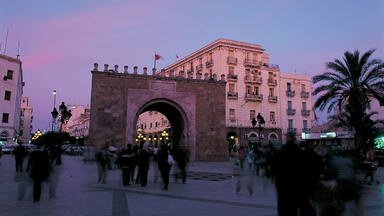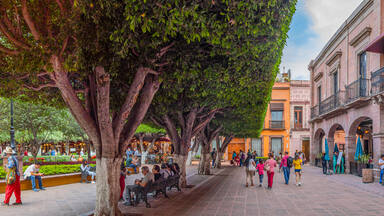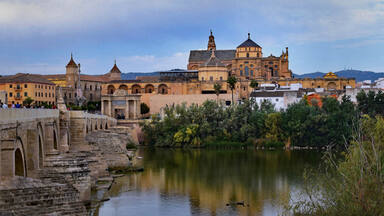"Founded in the 11th and 12th centuries to serve the caravans crossing the Sahara, these trading and religious centres became focal points of Islamic culture. They have managed to preserve an urban fabric that evolved between the 12th and 16th centuries. Typically, houses with patios crowd along narrow streets around a mosque with a square minaret. They illustrate a traditional way of life centred on the nomadic culture of the people of the western Sahara."
These four ancient towns, founded in the 11th and 12th centuries on the southern limits of the Saho-Sahelan desert, were originally built to serve the vital caravan trade routes across the Sahara. They are outstanding examples of medieval towns with architectural ensembles illustrating seven centuries of human history and bearing testimony to the intensity of changes linked with the important west-east and north-south trans-Saharan trade.
Between the 12th and 16th centuries, the towns became obligatory stages for the caravan routes linking North Africa, the river regions of western Africa, and the entire savanna zone. As a result, these trading and religious centres became the home of Islamic culture, which radiated an intense religious and cultural life. Today, they are the last surviving evidence of an original and traditional mode of occupying space, representing the nomadic culture and long-distance trade in a desert environment.
The medieval towns retained a specific urban morphology with narrow and winding lanes, houses built around central courtyards and original decorative stone architecture. As a result, they present a remarkably well-preserved urban fabric and houses with patios densely packed into narrow streets around a mosque with a square minaret. They also illustrate outstanding examples of the adaptation of urban life to the extreme climatic conditions of the desert, both regarding the construction methods, the occupation of space and agricultural practices.
Historic building attributes
Like the urban layout, most buildings present a defensive character, with few openings towards the exterior. They are built with local materials, such as stone and clay, with thick load-bearing walls.
Public buildings
Each town has its mosque and mahadra, social institutions which represent Islamic urban civilisation.
The mosques have a simple structure: a squared-planed minaret with thick stone walls and a single square or rectangular prayer hall covered by a vaulted roof supported on thick columns. The mosques follow a very austere aesthetic, without decoration or floor finish.
On the other hand, the mahadras are simple buildings with rooms grouped around an open courtyard.
Other buildings include the ancient manuscript libraries next to the mosque, the cemeteries and mausoleums.
Residential architecture
The majority of the urban area consists of single-storey dwellings around a central courtard. The typical buildings, built in stone, clay and wood, consist of a walled enclosure with small buildings of one or two rooms.
The façades have very few openings other than loopholes, ventilation holes, small windows or low doors. The main entrance to the dwelling is decorated and protected by toothed doors. The openings in the exterior walls, small and low, often have applied stone ornamentation with intricate geometric motifs. At the same time, the interiors feature colourfully painted clay decorations depicting interlaced motifs and rosettes.
Inside, rooms do not have fixed uses; instead, they take on different purposes depending on the season and the time of the day. This layout responds to the needs of nomadic people, who only inhabited the buildings for specific periods, and as such, the spaces were used only for storage for much of the year. Other service spaces were used as a kitchen, restrooms, shower rooms, animal pens, etc. In addition, the roof is used as a terrace.
Some inhabitants have decided to rebuild their old houses that had been left in ruins. Sometimes, the restoration has not followed best heritage practices, radically changing the house plan and reproducing more modern models. These create a rupture with the traditional housing typology of the ksour. This situation has been addressed by conservation actions on site.
Attributes of urban elements
The Ksour are fortified towns, presenting an impenetrable aspect. The urban fabric evolved between the 12th and 16th centuries and is very dense, with no open spaces and winding, narrow alleys that follow the natural topography. Originally crucial as places of instruction, buildings squeeze and interlock around a mosque, a school (medrasah) and housing for students and teachers. Around them were warehouses to store traded goods, as well as dwellings and inns for travellers. The mosques' squared and squat minarets dominate the Ksour and contrast with the horizontal layout of the cities. This urban layout and way of occupying the space are representative of the traditional lifestyle and the nomadic culture of the populations of Western Sahara, as well as the extreme weather conditions. The urban form, of great unity, shows a random distribution of dwellings in the unevenness of the ground, in irregular groups, with terraced floors and unexpected projections and indentations. Further away from the centre, houses and courtyards become bigger and wider spaced, grouping in small numbers to form isolated clusters.
"The urban structure of the historic centre of each of these four cities is composed of as many specific parts as there are tribes on whose land the towns were built. It should be emphasised that for the inhabitants of these desert settlements, their belonging to a place is much less important than their assignment to a particular human group (clan, tribe, etc.). The city is merely the territory where the interests of one or more human groups converge. Like the Arab-Muslim ksour, the Mauritanian fortified towns represent functional units with a pre-established urban order and building regulations. At the same time, Islamic law exhorts believers to avoid troubling or disturbing their neighbours. This law became a limiting factor for urban development, specifying the use patterns in urban spaces."
Palm groves
The towns of Chinguetti, Ouadane, and Tichttit have palm groves. The palm grove of Ouadane presents ancient constructions with enclosed walls, which delimited the zeribas (agricultural plots). Nowadays, the palm grove extends over several kilometres. In 1984, it counted approximately 35,000 palm trees, reputed to produce the best dates in the country. Today, the number of palm trees has been reduced.
The "Echeylal" palm grove irrigation system consists of wells, pools and irrigation systems. Some of the wells are traditional pendulum wells, while, today, others are more modern and built in concrete, drawing on the alluvial water table situated approximately 10-15m deep, weakened by the last years of drought. In addition, this system has been threatened by the loss of the workforce due to migration to urban centres.
Click to enlarge.
City walls and access
The four settlements had an enclosure, a wall or a dense area of dwellings placed on the periphery, of which some traces remain. Their location marks a limit between the old ksar and the new districts.
Each of the towns had specific significant access axes (alleys, paths or tracks) that ensured a direct link with the exterior; depending on the case, these roads were either caravan crossing points, or led to the town's well, palm grove or cemetery.
Streets and squares
The streets are narrow and winding on the rocky or sandy floor. Impasses and covered passageways called "dhouleyla" create dark areas sheltered from the sun. There is hardly any main street or public square, even in front of the mosque.
Interactive mapping
Use the interactive mapping tool to explore the different layers that compose the ksour's urban heritage. Browse through the tabs to navigate through the different scales of the city and the attributes of its urban heritage identity. Expand the legend on the bottom corner to discover more. Click on the icons to open pop-ups and learn more about the different elements.
Attributes of the wider setting of the city or settlement
The cities are examples of Saharan ksar settlements, well integrated into their environment. They are typically located on the outskirts of oases or fertile valleys and closely related to natural and agricultural landscapes such as palm groves. Their setting and relationship with the desert surroundings are important elements of their significance.
Intangible heritage values
The Ksour are significant as "the last surviving evidence of an original and traditional mode of occupying space, very representative of the nomadic culture and long-distance trade in a desert environment" (Statement of Outstanding Universal Value, SOUV). The towns have preserved ancient social and religious structures that witness their intense religious and cultural life, becoming "the brilliant homes of Islamic culture and thought", also thanks to their libraries and ancient manuscripts (SOUV). Their existance and development is linked to the economic activities of long-distance trade.
"Although Mauritania’s old towns have lost ground to the Sahara in the north and the Sahel in the south, along with suffering a devastating, decades-long drought, they refuse to go quietly into the night. The creative genius of ancient civilisations is still the driving force behind Mauritanian culture. The designs on Oualata’s walls are the same as those still drawn on the hands and feet of Mauritanian women. They can also be found in jewellery, leatherwork and woodwork, the embroidery on men’s garments, the dye of women’s veils, the weave of traditional carpets and even the bills of the nation’s currency, the ouguiya. The melodies of Vala, a famous musician from Chinguetti who has become an emblematic figure of Mauritanian music, are still played on the tidinit, the Moorish lute. Other traditional compositions, such as the awdid, once performed as the Tichitt caravans, were being loaded, immortalising the various aspects of life in the ksour when they were at the height of their glory.
Thus tradition is passed down from one generation to the next, like the beams that still pump water from old wells in the small farm plots and nonchalantly bow up and down across the centuries."
Social life
The social life of the towns is marked by the traditions that show the close relationship between the nomadic and sedentary populations. For instance, the Guetna (date harvest) brings together all city inhabitants around the palm groves, which have acquired a strong symbolic value through the centuries. Collaboration and mutual aid are the founding principles of social behaviour in these desertic towns. Men come together to build and repair roofs or excavate a new well, while women collaborate to make the fabric strips used to construct travelling tents for the nomadic populations.
C’est la période de la ‘Guetna’ en #Mauritanie la période de la récolte annuelle des dattes, moment de partage et de festivités.
— hammadi samba (@fuutaanke19) July 31, 2019
Quelques photos des diffèrentes variétés de dattes qu’on peut trouver dans le pays (via RMI Info) : pic.twitter.com/T2DgCRchxM
The Ancient Ksour :
an extraordinary cultural heritage
Contribution by Dr Ousmane Sao,
Permanent Delegation of Mauritania to UNESCO,
1 rue Miollis 75015 Paris
The history, richness, and diversity of Mauritanian heritage date back to earlier eras. Research findings indicate that in the late Neolithic period, the area now occupied by the Mauritanian desert was a refuge area where water was present. Despite the inevitable decline in rainfall, human populations have continued to occupy this area. This phenomenon can be explained by the adaptability of the populations to these new climatic conditions of increasing aridity, including the arrival of socially different groups.
The four historic settlements of Oualata, Chinguetti, Ouadane and Tichit, collectively known as ksour, have inherited a remarkable cultural wealth and an extraordinary architectural heritage. The Ksour, plural of Kasr, are fortified villages of pre-Saharan North Africa located along the wadis at the mouth of mountain streams.
- Ouadane, known as the city of the two valleys by scholars, is located in the Adrar. The old mosque, in ruins but partially restored, is the most outstanding element of this ensemble. According to local folklore, the mosque was the first building built by the town’s founders.
- Tichitt (or Tîchît) is a town in south-central Mauritania, in the Tdjikja area.
- Oualata is a town in the Nema area southeast of the country. The historic city of Oualata is more than 1,200 kilometres from Nouakchott, the capital.
- Chinguetti is home to the great mosque of the same name, located in the heart of the district, and most likely one of the oldest buildings in the city. Its minaret is a tower with a square base, partially covered by sand, that soberly stands 10 meters in the middle of the old houses.
In the 20th century, a team of archaeologists discovered what appear to be large villages of stone houses in the Tichitt-Walata region of Mauritania. They presented a priceless treasure whose exceptional value led the UNESCO World Heritage Committee to inscribe them on the World Heritage List in 1996 under criteria (iii), (iv) and (v). These four towns are the last witnesses of the prosperity of a region located at the intersection of the great caravan routes that, for a long time, linked the Maghreb and the Sahel. Placed at an intellectual crossroads where southern Europe, the Maghreb and sub-Saharan Africa met, this region opened simultaneously to the trade of goods and the exchange of knowledge. It became a hotbed of creation and inspiration, a place of intense religious life as well as numerous scientific and artistic activities. In the towns, a unique oasis culture developed and adapted to its ecosystem. Remarkably, these centres have preserved their urban fabric with densely packed patio houses leading into alleys, which grew around a mosque with minaret. The facades of these houses are often richly decorated and repainted after each rainy season.
Thanks to their pivotal position between the Sahel and the Sahara, these four cities became prosperous as stops and neural centres of the trans-Saharan trade. This commercial artery brought from the north manufactured goods (fabrics, weapons) and salt extracted in the heart of the Sahara (Idjil salt mines, in the north of Mauritania) in exchange for gold and enslaved people from sub-Saharan Africa. Moreover, these stopover towns provided travellers’ accommodation and supplies for the caravans, as well as security, to the point that the caravan tracks carried the names of the tribes that controlled them. Thus, as early as the 9th century, the Western trans-Saharan track became the road of the Lemtouna, a nomadic Amazigh tribe from the Sanhaja (Znaga), traditionally inhabited areas from Souss to the Adrar plateau. The history of this track was affected by a move of caravan tracks towards the East, with the advancement of trading posts in the Maghreb or Sahel.
Today, despite the permanent threats of desertification, water scarcity, the exodus of young people and the negative consequences of modernisation, Ancient Ksour still have the potential, with their sensible development, to contribute to the knowledge of the rich architectural heritage of the time.
The urban archaeology of these historic cities reinforces their historical importance, especially in the remains of earlier periods. Their settlement pattern, a structured living environment where streets represent community spaces, is a testimony to local knowledge and relays a strong community feeling. The urban fabric comprises traditional houses grouped along narrow streets, with images and designs linked to religious symbolism.
The housing style of the Ksour is characterised by compact streets and neighbourhoods, offering an exceptional example of human settlement. Adopted by the community as a pleasant and acceptable way of building, this housing style has determined the structure of the settlement, as the community's needs are expressed in its public spaces at the settlement level and self-sufficient streets closed by gates.
How to manage and protect this heritage?
The Mauritanian government, aware of the importance of these historic towns, has been running the annual Festival of Historic Cities for ten years. This celebration later became the Festival of Heritage Cities.
The establishment of the festival was accompanied by the proposal for a heritage management plan, an essential tool for the conservation and sustainable management of the cultural heritage of the Ancient Ksour. The objective of the management plan is to ensure the protection and enhancement of the Outstanding Universal Value of the Ksour while promoting their sustainable development through the approach of the Recommendation on the Historic Urban Landscape. It aims to integrate cultural heritage conservation and the sustainable urban development of historical areas as a vital component of all cities’ decision-making processes. The plan was incorporated into Law 46-2005 on the protection of tangible cultural heritage, which constitutes the legal framework for the management and development of the ancient Ksour of Ouadane, Chinguetti, Tichitt and Oualata.
The effective implementation of a Heritage Management Plan must be ensured in conjunction with the finalisation, ratification and implementation of the amendment and additions to the development control regulations. To complete the Heritage Management Plan, a Tourism Development and Management Plan should be prepared, approved and implemented. At the same time, local plans must be completed and implemented following the Heritage Conservation Plan. The conservation of historic houses should be given special consideration. Complete and accurate documentation of the property's historic buildings is required, following internationally recognised standards for the documentation of historic buildings for conservation and management. Finally, conducting a detailed assessment of the area and the impact of new construction and city development projects would be advisable
Lire l'original en francaisReferences
- ICOMOS. (1996). Advisory Body Evaluation. UNESCO Archives.
- Ould Ebnou, M. (2000). Les Trésors ensablés des cités mauritaniennes. Le Courrier de l'UNESCO, 53, 12, p. 26-28. https://unesdoc.unesco.org/ark:/48223/pf0000121335_fre
- Sidorenko, A. (2003). Projet-pilote « Sauvegarde et développement des villes du patrimoine mondial en Mauritanie » : exemple d’une coopération tripartite Unesco–Gouvernement mauritanien–Banque mondiale [Pilot project "Safeguarding and developing World Heritage cities in Mauritania"], World Heritage Papers 13: Linking Universal and Local Values: Managing a Sustainable Future for World Heritage. Paris, UNESCO World Heritage Centre. https://whc.unesco.org/en/series/13/
- UNESCO, Caumes, P. (2005). Villes de mémoire: anciens ksour de Mauritanie. Paris, UNESCO World Heritage Centre. https://unesdoc.unesco.org/ark:/48223/
- World Heritage Committee, 34th Session. (2010). Decision 34 COM 8E. https://whc.unesco.org/en/decisions/4261
- World Heritage Committee, 34th Session. (2010). Document WHC-10/34.COM/20. https://whc.unesco.org/document/104960
- World Heritage Nomination Dossier 750. (1996). UNESCO Archives.
Links
- Ancient Ksour of Ouadane, Chinguetti, Tichitt and Oualata, inscribed on the UNESCO World Heritage List (1996)
- Date palm, knowledge, skills, traditions and practices, inscribed on the Representative List of Intangible Cultural Heritage of Humanity (2022)
- Arabic calligraphy: knowledge, skills and practices, inscribed on the Representative List of Intangible Cultural Heritage of Humanity (2021).
- Knowledge, know-how and practices pertaining to the production and consumption of couscous, inscribed on the Representative List of Intangible Cultural Heritage of Humanity (2020).
© UNESCO, 2023.
Project team: Jyoti Hosagrahar, Mirna Ashraf Ali, Alba Zamarbide, Carlota Marijuan Rodriguez, Giacomo Martinis, Marta Zerbini.










